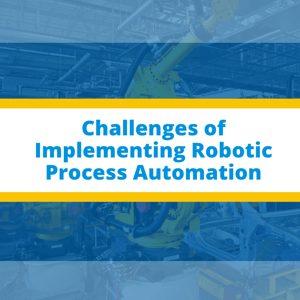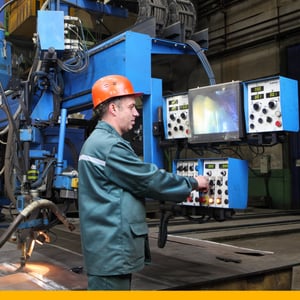 Robots aren’t plug & play devices, especially not in an industrial setting. They require considerable prep-work, ranging from the initial design stage, to implementation, to regressive testing & troubleshooting. Things can get even more complicated when you are trying to achieve a great degree of automation through robots that work in conjunction, not just from the technical point of view, but from the financial side as well.
Robots aren’t plug & play devices, especially not in an industrial setting. They require considerable prep-work, ranging from the initial design stage, to implementation, to regressive testing & troubleshooting. Things can get even more complicated when you are trying to achieve a great degree of automation through robots that work in conjunction, not just from the technical point of view, but from the financial side as well.
With that being said, Robotic Process Automation (RPA) is no longer a supplementation to existing human labor; it is a necessity. Without RPA, companies can lose their productive edge and get driven out of the market altogether, rendering the “robots-replacing-humans-job” null & void altogether. Implementing RPA, on the other hand, can digitize labor and introduce technologies such as machine intelligence and Big Data to the plant floor, while leveraging the power of well-developed concepts such as cloud-computing. The benefits are far-reaching, positively attributing employees as well, helping them with hectic tasks, not just those that involve physical movements, but those with heaps of raw data.
Unfortunately, getting RPA to your factory isn’t the easiest thing to do. There are dozens of interlinked challenges making it daunting for technical & business teams to carry out such an implementation. The following is a list of the most major ones, along with a strategy on how they can be resolved.
Process Analysis Issue
In order to implement robotics for process automation, it is very important that all teams are supportive, be it leadership or technical personnel. This helps to build confidence around the implementation and ensures that everyone is willing to work towards the project’s success. Sounds easy, right? It isn’t. Operation leads are often confused when it comes to implementation. It can be daunting to get them to believe in the concept. This usually happens when the leads are tasked with an array of responsibilities without giving them an understanding of the concept itself. To deal with this, the operating leads must be helped in understanding how RPA would benefit them and the company. A set of seminars or workshops would be a good starting point for this.
Business Case Issues
No project, big or small, can be successful unless it has the full blessing of the top-tier management. All management functions must be briefed with the RPA implementation, ranging from investor groups to operating personnel. All processes that will be impacted as a result of this must be identified as well and alternatives should be drawn up beforehand.
RPA Development
RPA development is still a fresh concept. This means that there may be difficulties in finding the right skillset for getting the job done. Since you’re looking for a customized solution, and not one that says, “one-size-fits-all," considerable effort must be made to track down effective RPA teams. In addition to requiring effort, RPA development can be expensive as well. A common issue in organizations is lack of design teams. Therefore, before the project is given a go-ahead, the HR must ensure the required skills are either present or accumulated through hiring.
Mismanagement of Responsibilities
It is well-known that once done, RPA will prove fruitful for your company in all aspects. But how does one get there? The new responsibilities that are created as part of the RPA implementation may create confusion among different functions. It is important that roles be defined during the design process so that every team is aware of the new set of responsibilities they have. Realignment of resources must be carried out all the way to the bottom so that every employee is empowered.
 Lack of help from local team members
Lack of help from local team members
This is a well-recorded challenge when it comes to implementing RPA. If the local team members aren’t motivated enough, they may not actively help in getting the work done. A well-staffed and knowledgeable team is key to a successful implementation that is both cost and time effective.
Economics
Robotics Process Automation can help boost performance of processes by 70–80 percent, however, the cost of implementation isn’t nominal. The level of automation drives the cost. For instance, it is very much possible that an automated process has a cost that is five times that of a non-automated one. Common additions include hiring new staff, training employees and additional operation & maintenance costs. Before jumping into RPA, one should do a cost-benefit analysis to ensure long-term ROI.
Maintenance
After an RPA implementation has been carried out, maintaining it is paramount to its continued profitability. During the first few months, this will be a challenge. A scheduled maintenance protocol must be introduced and enforced so that any issues that may spring up are nipped in the bud.
Picking the wrong RPA
If the design phase has been rushed, then managers may only identify issues with the RPA during the implementation phase. By that time, the company would’ve burnt through a lot of cash, making any roll-back highly improbable. Nonetheless, there’s no benefit of an implementation if it doesn’t do the job it is intended for. Still, most companies indulge in unplanned implementations and end up with operational issues that may be of extreme severity, rendering the entire project useless.
 Infrastructure Issues
Infrastructure Issues
Dealing directly with infrastructure is one of the toughest challenges with RPA. It will be difficult to get every employee on board with the new implementation and things will get complicated especially if your company doesn’t have an interconnected system. A centralized infrastructure team is essential to an RPA implementation’s success and will help fasten the pace of the project.
Post-implementation adoption
Once the implementation has been carried out, employees may feel threatened for their tasks or positions altogether. This can lead to a situation where the employees sub-consciously or otherwise ignore the system and continue doing things the old way. This isn’t new, and the issue is known to surface every time an automation breakthrough is made. Timely intervention from the leadership can prevent this from happening. By making them understand that RPA would benefit them and not substitute their jobs, the implementation can fulfill its core purpose. Furthermore, it can lead to innovation from within the employees as to how the system can be utilized in a better manner. This will ultimately lead to greater productivity and swollen economic growth.
Interested in learning more? Visit our website www.premierautomation.com, or talk to one of our specialists today.




